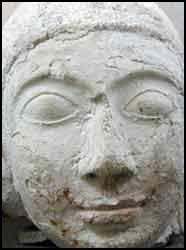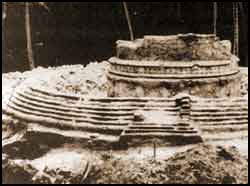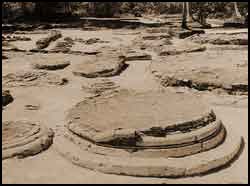
The head of an image of Buddha excavated from a site in Thoddu Island. "I wanted to go to the Maldives, of which I have heard so much." These were the words with which Ibn Batuta opened his account of his voyage to the islands. It is quite obvious that the Maldives was very well known in his times. What made this small and isolated archipelago so famous?
The answer may lie in Maldivian cowry shells, which were used as money all over Asia and the Middle East.
Some of these cowry shells have been located in parts of China, the Middle East and South Asia. The people of the ancient world knew that the cowries came from islands in the Indian Ocean.
Those days the Maldives was not just famous but also prosperous and perhaps influential. Roman historian Amianus Marcelinus (circa 320-390 AD) records an embassy from the Divis (Maldivians) to the court Emperor Julian in 362 AD bearing gifts. Chinese history records King Sri Baladitiya of the Maldives sending gifts in the years 658 AD and 662 AD to Emperor Kao-Tsung (649-683 AD) of the Tang dynasty.
Going back to earlier times cowry shells have been located in the ruins of the Indus Valley civilization dating to the second millenium BC. Even if the Maldives was not inhabited by then, obviously people were travelling to the islands to harvest cowries. It is possible that it may have been people of this civilization that first settled in the Maldives. |

Ruins of a dagoba in Thoddu
When exactly was the Maldives settled? We really don't know. . However, it is certain that the islands have had continuous habitation for about 2500 years. The first settlers may have been travelers who were forced to settle in the Maldives for various reasons such as shipwreck. It is quite possible that people migrated to the Maldives were fishing communities from Southwest India. Names of some of the islands and some of the maritime terms used in Maldives are derived from the Dravidian language spoken by the people of that area. This connection with Southwest India can also be deduced from legendary folklore and traditions of the people.
There is overwhelming evidence that early Maldivians were Buddhists. Ancient sites discovered in the Maldives reveal Buddhist ruins dating to the early half of the 1st millenium BC. The archaeological sites at Kaashidhoo belong to 3rd or 4th century AD. Thus, Buddhism must have come to the Maldives sometime before that. As the Maldives was well known in the region, it is conceivable that one of Emperor Ashoka's (265-238 BC) original missions sent out to spread Buddhism in South Asian countries may have come to the Maldives.
Many other Buddhist sites have been found in the Maldives dating back to various periods in islands as far as Nilandhoo, Gan and Fuamulaku.
There are other theories that try to explain how Buddhism came to the Maldives. One of these is that it came from East India along with the first colonists. According to the Mahavansa the ancient record of Sri Lanka, while Prince Vijaya was sailing to Sri Lanka around 500 BC one his ships strayed and landed at an island called Mahiladvipika, which most probably was the Maldives. It is also said that at that time the people from Mahiladvipika used to travel to Sri Lanka. These facts are interesting because it indicates that the Maldives was settled simultaneously with Sri Lanka, and discredits the theory that Maldives was colonized by Sri Lankans.
There are other factors too that cast doubt on the Sri Lankan colonization theory. First, Sri Lankans were basically land based people. They rarely traveled across the sea, perhaps due to traditions inherited form their Aryan ancestors. Second, linguistically Dhivehi is an equal sister of Sinhala and not a daughter language, which would have been the case the colonization theory been correct.
With the opening of sea routes in later days the fame of Maldives increased because of its presence on the route from the Middle East to the Far East. The presence of treacherous reefs made it imperative for travelers and cartographers to take serious note of it. Records left by writers and travelers from the Middle East to this region during the final years of the first millennium after Christ and during the 11th and 12th centuries AD contain geographical information about the islands of the Maldives, the means of livelihood and the traditions of Maldivians. These writers include Sulaiman, Abu Zaidi, Al Masudi, Al Biruni and Al Idrisi. Even a Roman manual of navigation from the first century AD written by Periplus Maris Erithraei mentions islands assumed to be the Maldives. Ptolemy, the famous 2nd century AD Greek astronomer, mathematician and geographer, refers to the Maldives in his Geography.
 The site of the dagoba
|




